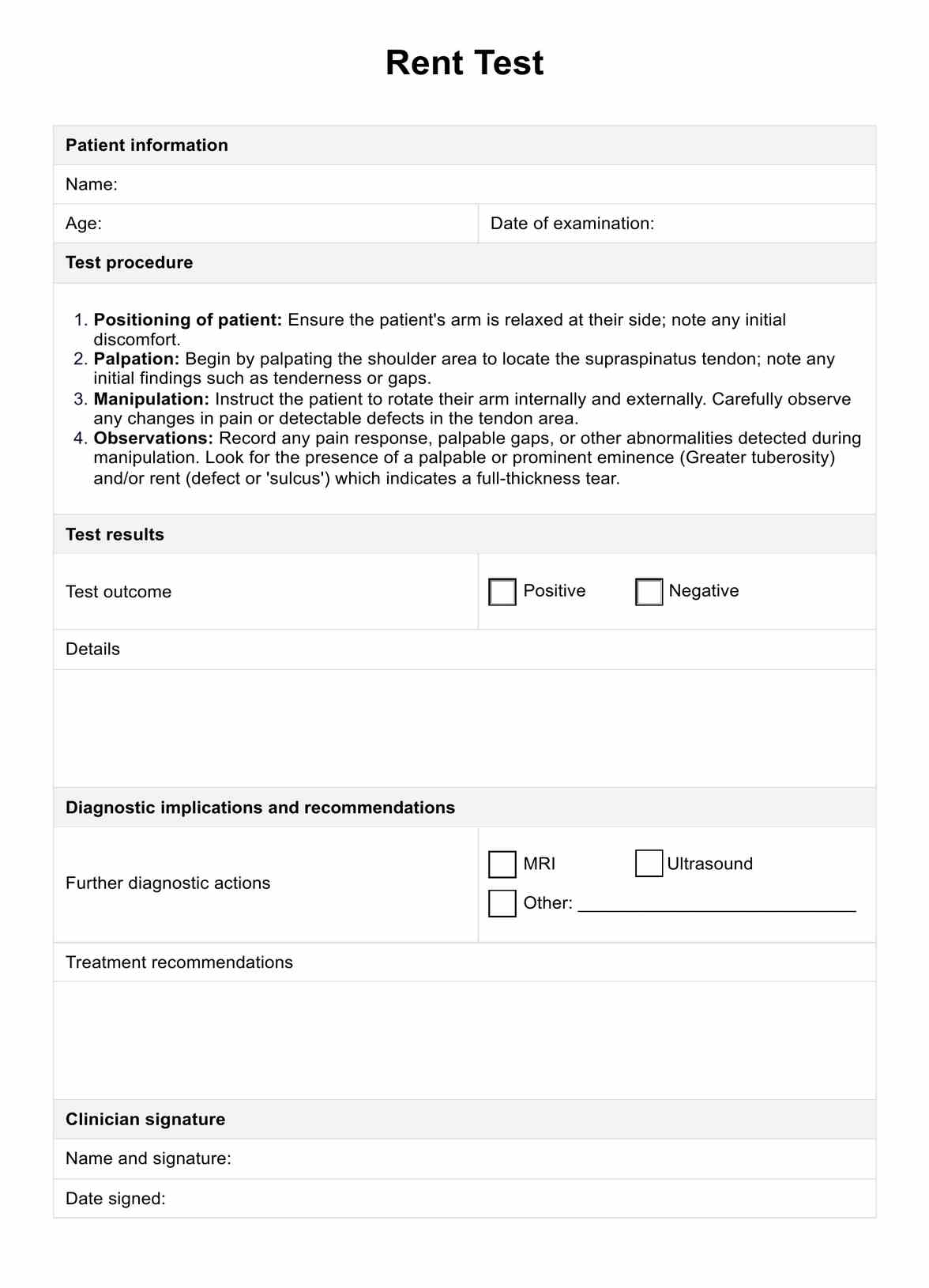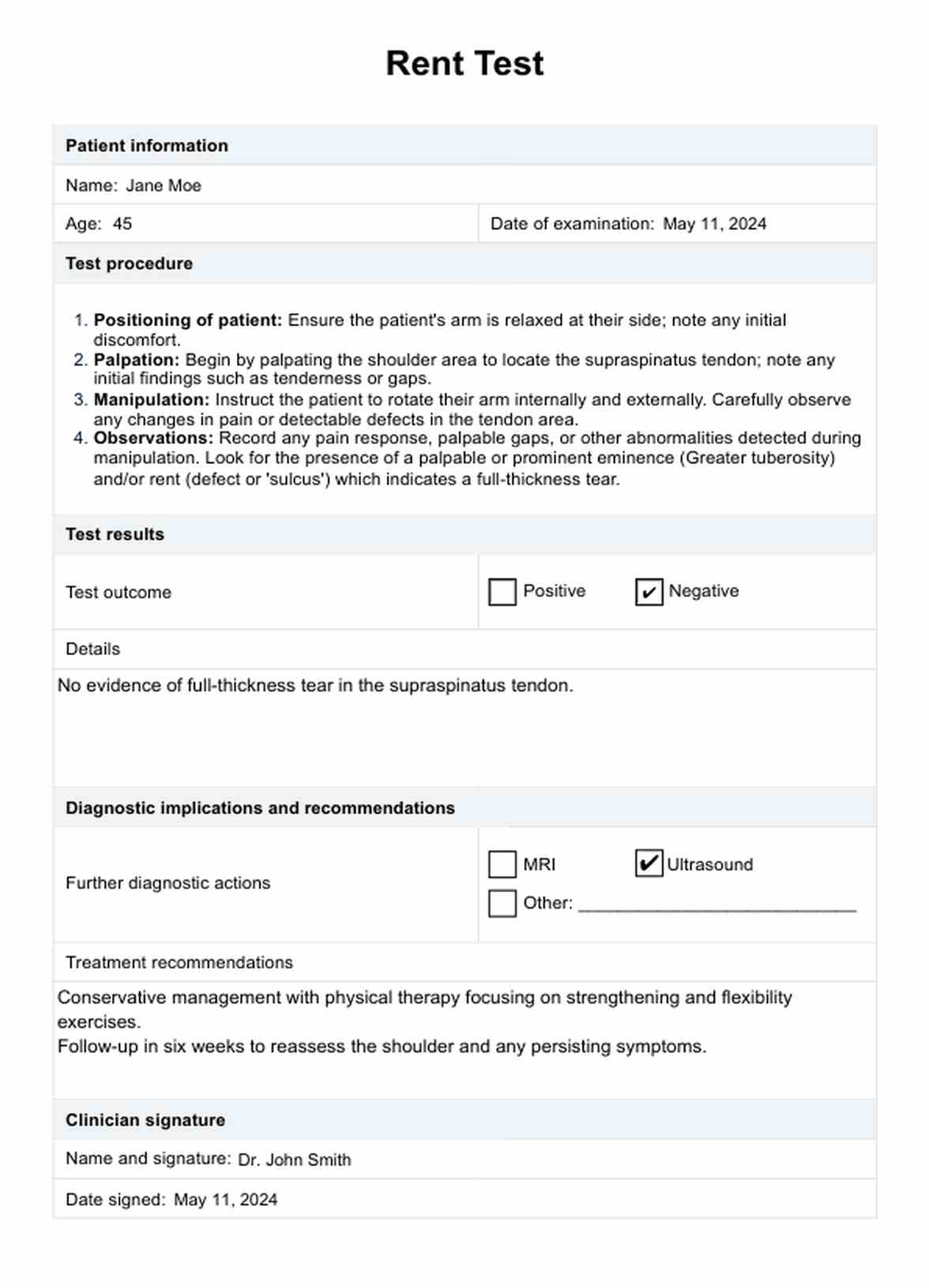Rent Test
Explore effective treatments for rotator cuff tears, learn about the Rent Test, and download our free template for precise assessments.


What is a rotator cuff tear?
A rotator cuff tear involves a rupture or tear of one or more of the tendons of the rotator cuff, a critical group of tendons and muscles that provide stability and movement to the shoulder. These injuries can range from mild strains to full-thickness tears, significantly impacting shoulder function.
Symptoms of rotator cuff tears
Symptoms of rotator cuff tears include persistent shoulder pain that intensifies with movements, particularly when lifting objects or reaching overhead. This pain can be sharp during specific activities or a dull ache that permeates the shoulder area, worsening at night and potentially disrupting sleep. Patients frequently experience a noticeable weakness in the affected shoulder, which can significantly hinder daily activities such as dressing, driving, or performing any task that involves raising the arm.
In addition to pain and weakness, the shoulder joint often has a reduced range of motion. This limitation can manifest as difficulty performing routine motions like reaching behind the back or extending the arm sideways or overhead. Some individuals may hear clicking or popping sounds when moving their shoulders. Over time, these symptoms can lead to stiffness as individuals avoid movements that trigger discomfort, further decreasing shoulder mobility.
Causes of rotator cuff injuries
Rotator cuff injuries commonly result from repetitive stress, acute trauma, or degenerative changes in the shoulder. Factors such as age, certain sports, or physically demanding occupations increase the risk of these tears.
Rent Test Template
Rent Test Example
What is the Rent Test?
The Rent Test is a clinical examination used to assess the integrity of the rotator cuff tendons. It focuses particularly on detecting tears in the supraspinatus tendon, one of the most commonly affected tendons.
How is this test conducted?
The Rent Test is a clinical procedure used to assess the integrity of the rotator cuff, particularly the supraspinatus tendon, by manually exploring for abnormalities in the shoulder's structure.
- The patient stands with the affected arm relaxed at their side to ensure the shoulder is naturally unstressed.
- The examiner uses their fingers to palpate around the shoulder area, specifically targeting the supraspinatus tendon. They meticulously check for gaps or tender spots that could indicate a tear.
- The patient is then asked to rotate their arm internally and externally. This manipulation is crucial as it can exacerbate pain or make a gap in the tendon more palpable, aiding in diagnosis.
How are the results interpreted?
Interpreting the results of the Rent Test involves analyzing the physical findings during the examination to determine the presence or absence of a rotator cuff tear.
- Positive test: A palpable gap or the elicitation of noticeable pain during the arm's rotation suggests a possible full-thickness rotator cuff tear. This finding is significant as it often indicates the need for further diagnostic imaging or treatment intervention.
- Negative test: The absence of a palpable gap or pain during the test generally indicates that a full-thickness rotator cuff tear is unlikely. However, it is important to note that this result does not completely exclude the possibility of partial tears or other types of shoulder injuries.
These introductions add context to each section, guiding the reader through the steps and significance of the Rent Test in diagnosing rotator cuff injuries.
How to use our Rent Test template
Our printable Rent Test template provides a structured approach to documenting findings from the Rent Test.
Step 1: Download our template
Begin by downloading our Rent Test template, designed to streamline the process of conducting and documenting the Rent Test. This template is crucial for organizing patient data effectively.
Step 2: Gather details
The template includes sections for entering patient information, which helps maintain records and track patient history.
Step 3: Document test results
It provides designated areas to record the findings from the Rent Test systematically. This includes noting any palpable gaps, pain responses, and the patient’s ability to perform movements as instructed during the test.
Step 4: Make clinical observations
There is space to detail clinical observations vital for a comprehensive view and clinical diagnosis of the patient's shoulder health. This might include notes on the patient's reported pain levels, visible signs of discomfort during the test, and other relevant clinical insights.
Step 5: Plan treatment
The documented results and observations can then inform further diagnostic actions or plan appropriate treatment strategies, ensuring a targeted approach based on the specific findings of the Rent Test.
Using this template ensures that all pertinent information is captured accurately and efficiently, aiding in diagnosing and managing rotator cuff injuries.
Benefits of conducting this test
The Rent Test is invaluable for the early diagnosis of rotator cuff tears, playing a pivotal role in clinical orthopedics by allowing for timely and appropriate interventions. Early identification of these injuries through the Rent Test can significantly halt the progression of damage, which is crucial in preventing the worsening of symptoms and the subsequent decline in joint function. This helps manage pain more effectively and preserves the shoulder's range of motion and strength.
Moreover, an early diagnosis facilitates more accurate treatment planning. It enables healthcare providers to customize rehabilitation programs and treatment regimens that are ideally suited to the severity and nature of the tear.
Implementing these tailored strategies promptly can markedly improve the prognosis, reducing the likelihood of complications that might otherwise necessitate surgical intervention.
Consequently, the Rent Test is not just a diagnostic measure but a preventative tool that helps maintain overall shoulder health and functionality, ultimately improving patients' quality of life.
Rotator cuff tear treatments
Treatment options for rotator cuff tears range from conservative to surgical, depending on the severity of the tear and the patient's circumstances.
Conservative management typically includes physical therapy, which focuses on strengthening the shoulder muscles and improving flexibility, thus relieving pain and restoring function. Pain management may also involve medications and corticosteroid injections to reduce inflammation and discomfort.
In cases where conservative treatments do not provide sufficient relief or in the event of more severe tears, surgical intervention may be necessary. Surgery aims to repair the torn tissue, thereby restoring the shoulder's normal function and strength.
A comprehensive rehabilitation program is essential post-surgery to aid recovery, enhance the shoulder's mobility, and reduce the chances of future injuries. The choice of treatment is influenced by factors such as the patient's level of activity, overall health, and specific goals for recovery.
Commonly asked questions
Not always. Many tears can be managed with physical therapy, especially if diagnosed early. Surgery is generally reserved for full-thickness tears or those that fail to respond to conservative treatment.
Recovery can vary but typically involves several months of rehabilitation to restore strength and functionality to the shoulder.
The treatment approach for a full-thickness rotator cuff tear often depends on several factors, including the patient's age, activity level, and overall health. Non-surgical methods like physical therapy and medications are commonly used when the patient's condition allows. However, surgical intervention, known as rotator cuff repair, might be necessary for more severe tears or when the patient experiences ongoing pain and functional impairment despite conservative treatment. Clinical tests and examinations of the patient's arm and shoulder will guide decision-making.

.jpg)





































































































